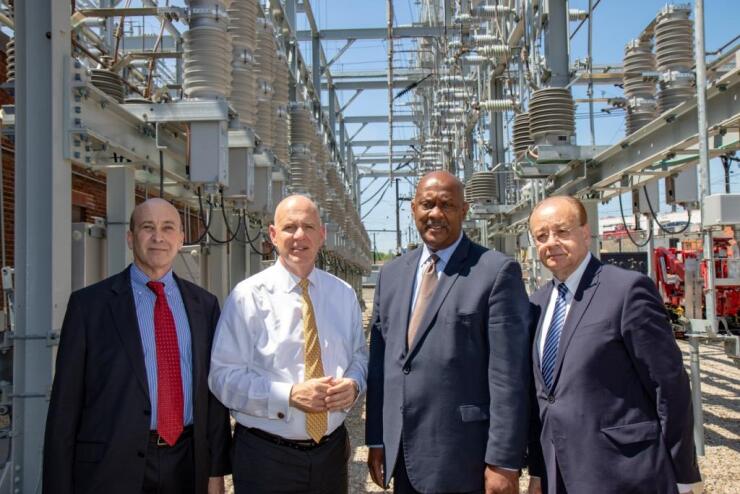A long-awaited transit project in Philadelphia reached the finish line thanks to a federal grant program.
“At a time when our capital budget would not allow us to overhaul the critical Wayne Junction Power Substation, the federal TIGER grant provided the path forward,” said Southeastern Pennsylvania Transportation Authority General Manager Jeffrey D. Knueppel during a May 21 event at the facility to commemorate National Infrastructure Week. “Thanks to this investment, SEPTA was able to strengthen an essential part of our Regional Rail operations and improve system reliability.”

The Trump administration proposed eliminating the Transportation Investment Generating Economic Recovery grants in its budget requests earlier this year before the program was ultimately restored.
The facility, which provides power to six of SEPTA’s 13 electrified regional rail lines, had not seen any major reconstruction since the 1930s due to funding constraints prior to receiving the 2012 TIGER grant.
The Wayne Junction construction process commenced thanks to a $12.8 million grant at around the same time SEPTA was able to tackle other deferred projects thanks to Act 89, which Pennsylvania lawmakers approved in November 2013 to provide long-term funding for transportation capital improvements.
SEPTA spokesman Andrew Busch said Act 89 combined with the TIGER grant enabled it to more than double its capital program in recent years to more than $600 million and chip away at its state of good repair backlog, which now stands at roughly $4.6 billion. Busch said SEPTA would have been forced to shut down nine of 13 regional rail lines without the federal and state funding.
“We would have ended up with a skeleton of the current system,” said Busch. “With Act 89 and help such as the TIGER grant, we have been able to complete a number of much-needed projects and budget for others in the coming years.”
SEPTA, which has bond ratings of A1 from Moody's Investors Service and double-A from Fitch Ratings, is the primary transit provider for the Philadelphia region and the sixth largest transportation agency in the nation.
In addition to the regional commuter rail service, it operates Philadelphia city buses, trolleys and subways.
The modernized substation was unveiled three days before SEPTA released a $749.62 million 2019 fiscal year capital budget aimed at improving infrastructure, replacing aging vehicles and implementing technology improvements. The authority is also planning a 12-year capital program totaling $7.4 billion, which includes federal funding authorized under the Fixing America’s Surface Transportation Act and money from Pennsylvania's Act 89.
Barry Seymour, executive director of the Delaware Valley Regional Planning Commission, said that while the Wayne Junction Substation completion is important, the agency needs to proactively gear up for future needs. He said federal, state, local and even private funding will be needed to help keep future SEPTA infrastructure projects on track.
“Federal dollars are about 50 cents on the dollar compared to 1993 the last time there was an increase in the federal gas tax,” said Seymour. “There are a lot of capital needs that are getting diverted because of lack of funding.”
American Public Transportation Association president and CEO Paul P. Skoutelas said the challenges SEPTA faces finding funding for infrastructure upkeep are shared by many public transportation systems nationwide. A new study conducted by the Economic Development Research Group Inc. for APTA said that not tackling a $90 billion backlog of bus and rail needs results in a loss of $340 billion in business revenue to the U.S. economy over a six year period. The

“This budget included significant increases in federal investment in public transit,” Skoutelas said in a statement. “While this is a positive step forward in helping to address the nation’s aging public transit infrastructure, this momentum must be maintained by providing similar or higher funding levels for 2019.”
Janney Capital Markets municipal analyst Alan Schankel said he is a “large fan of TIGER grants," but cautioned that the program, with around $500 million in annual appropriations, lacks enough funding to sufficiently aid the nation’s infrastructure needs.
“The 2012 grant for the recently completed Wayne Junction Power Substation replacement in Philly is particularly important, since it provides power to about half of the center city-to-suburbs spokes of SEPTA’s train system,” said Schankel, a Philadelphia native. “City residents and workers rely heavily on the region’s SEPTA transit system, of which I have been a lifelong user.”
Congress approved a 2018 omnibus spending bill in March for the fiscal year that ends Sept. 30 that included a $1 billion increase to the TIGER program to $1.5 billion. The measure included language to ensure that at least 30% of TIGER grant money goes to rural communities.
The U.S. Department of Transportation rebranded TIGER in April as the Better Utilizing Investments to Leverage Development or “BUILD” program. The USDOT said criteria for grant funding under BUILD and TIGER are “essentially the same,” but will place a new emphasis on projects that secure more non-federal revenue. Seymour said changes to TIGER create even more reason for SEPTA to proactively prepare for future infrastructure needs through either increased state dollars or public-private partnerships.
“Funding will go primarily to projects that have a large share of local funding,” said Seymour. “It is a little up in the air how it will work.”





